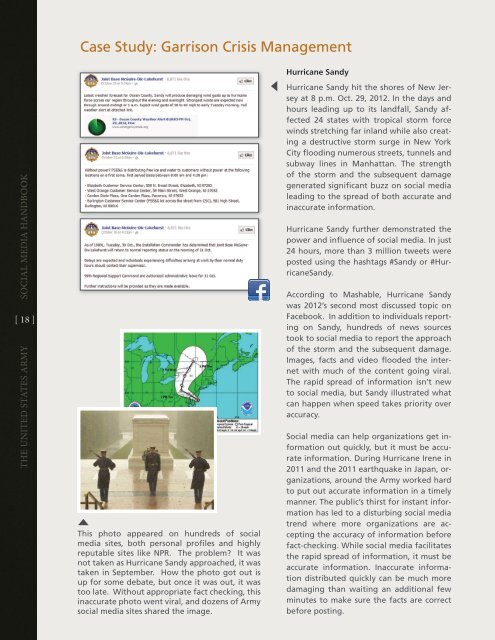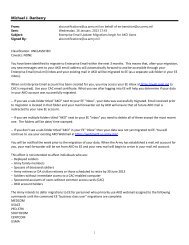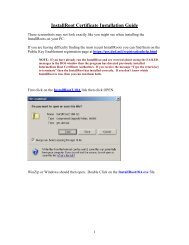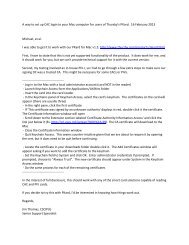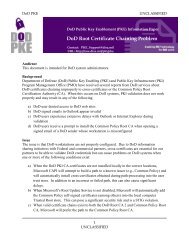U.S. Army Social Media Handbook - 25th Infantry Division - U.S. Army
U.S. Army Social Media Handbook - 25th Infantry Division - U.S. Army
U.S. Army Social Media Handbook - 25th Infantry Division - U.S. Army
Create successful ePaper yourself
Turn your PDF publications into a flip-book with our unique Google optimized e-Paper software.
Case Study: Garrison Crisis Management<br />
Hurricane Sandy<br />
The United States <strong>Army</strong> social media handbook<br />
[ 18 ]<br />
This photo appeared on hundreds of social<br />
media sites, both personal profiles and highly<br />
reputable sites like NPR. The problem? It was<br />
not taken as Hurricane Sandy approached, it was<br />
taken in September. How the photo got out is<br />
up for some debate, but once it was out, it was<br />
too late. Without appropriate fact checking, this<br />
inaccurate photo went viral, and dozens of <strong>Army</strong><br />
social media sites shared the image.<br />
Hurricane Sandy hit the shores of New Jersey<br />
at 8 p.m. Oct. 29, 2012. In the days and<br />
hours leading up to its landfall, Sandy affected<br />
24 states with tropical storm force<br />
winds stretching far inland while also creating<br />
a destructive storm surge in New York<br />
City flooding numerous streets, tunnels and<br />
subway lines in Manhattan. The strength<br />
of the storm and the subsequent damage<br />
generated significant buzz on social media<br />
leading to the spread of both accurate and<br />
inaccurate information.<br />
Hurricane Sandy further demonstrated the<br />
power and influence of social media. In just<br />
24 hours, more than 3 million tweets were<br />
posted using the hashtags #Sandy or #HurricaneSandy.<br />
According to Mashable, Hurricane Sandy<br />
was 2012’s second most discussed topic on<br />
Facebook. In addition to individuals reporting<br />
on Sandy, hundreds of news sources<br />
took to social media to report the approach<br />
of the storm and the subsequent damage.<br />
Images, facts and video flooded the internet<br />
with much of the content going viral.<br />
The rapid spread of information isn’t new<br />
to social media, but Sandy illustrated what<br />
can happen when speed takes priority over<br />
accuracy.<br />
<strong>Social</strong> media can help organizations get information<br />
out quickly, but it must be accurate<br />
information. During Hurricane Irene in<br />
2011 and the 2011 earthquake in Japan, organizations,<br />
around the <strong>Army</strong> worked hard<br />
to put out accurate information in a timely<br />
manner. The public’s thirst for instant information<br />
has led to a disturbing social media<br />
trend where more organizations are accepting<br />
the accuracy of information before<br />
fact-checking. While social media facilitates<br />
the rapid spread of information, it must be<br />
accurate information. Inaccurate information<br />
distributed quickly can be much more<br />
damaging than waiting an additional few<br />
minutes to make sure the facts are correct<br />
before posting.


